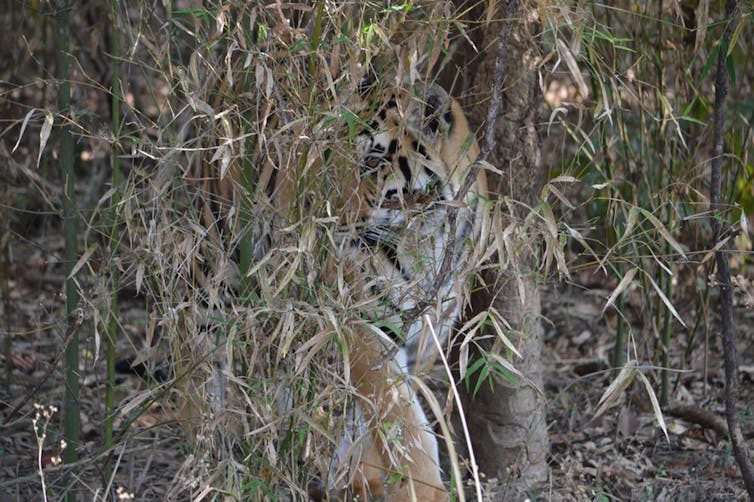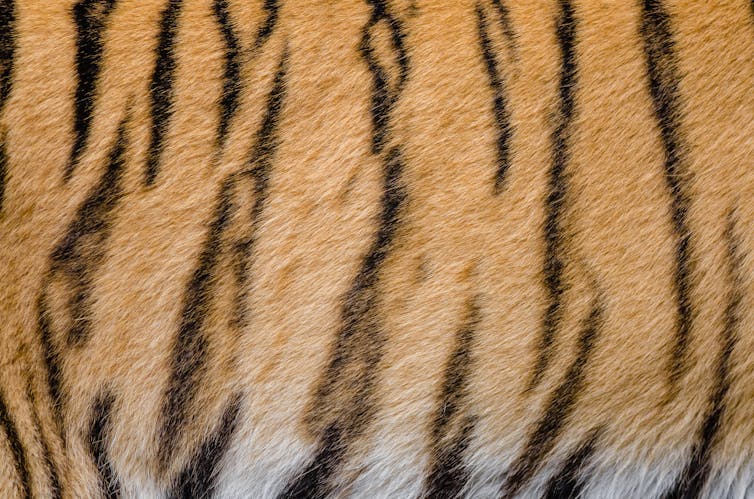You Think You Know Me Let Tell I the Kind of Tiger Can Change It Stripes Song

Curious Kids is a series for children of all ages. If you lot have a question you'd similar an skilful to reply, send it to curiouskidsus@theconversation.com.
Why practice tigers accept stripes? – Vidit M., age viii, New Delhi, India
When tigers stalk their casualty, usually in the murky lite of sunset or dawn, they are nearly invisible. Whether they live in grasslands, forests or jungles, wild tigers have deep orange coats with nighttime stripes. So how does such a brightly colored animal stay concealed well enough to hunt successfully?
The reply: camouflage!
Green tigers?
In my work as a zoological veterinarian, I've seen upward shut how diverse animals' coats, feathers, colors, spots and stripes have evolved to either help them attract a mate or disguise them. Camouflage – or "cryptic coloration" – allows them to hide, undetected.
Since tigers are apex predators at the meridian of the nutrient chain, they don't demand to hide from animals that might eat them. They are carnivores – they eat meat – and they rely on stealth to chase successfully.

They're helped by the limited vision of their preferred prey. Deer and other hoofed animals can't see the full range of colors, much similar a colorblind man.
Information technology helps them see better in dim light, merely it also makes them vulnerable. To their eyes, the tiger'south fur isn't bright orangish: it looks green and matches the background.
Hidden in plain sight
The tiger's markings as well play an important part. Their vertical stripes, which range from brown to black, are an example of what biologists call disruptive coloration. They help break up the cat'south shape and size so it blends in with trees and tall grasses.
That's important considering these predators don't hunt in groups, like a panthera leo, or accept the speed of a cheetah. Tigers are solitary cats that rely on stealth and cover-up to survive.

Stripes even vary among the six tiger subspecies. The Sumatran tiger subspecies has much narrower stripes than the others and has more of them. This helps information technology stay subconscious in its dumbo jungle home.
Unique as a fingerprint
When yous look at dissimilar tigers up close, equally I practise in my piece of work, yous'll run across that each of their stripe patterns is unique, merely like a zebra'south. No two are the same. They're as singled-out as homo fingerprints.

This allows researchers who study them in the wild to identify and count individual tigers. They employ remote cameras to take pictures of the animals when they walk past. Using this method, tiger experts gauge that only nigh 3,400 wild tigers remain beyond their Asian homeland.
It's not just their fur that'south inked with blackness stripes. When we have to sedate a tiger to care for an injury or practise dental work, we shave their fur. It's always surprising to see that their skin most looks similar information technology's been tattooed: It has the same striped pattern equally its fur!
White tigers
And then if stripes camouflage tigers from potential casualty, why are some of them white? Don't they stand out in the jungle, even with their stripes?
Aye, they do! Considering we've seen them on Television receiver or in wildlife tourist attractions, we may think they're common, just they're not. A genetic mutation in Bengal tigers gives them their milky white fur. Both parents must carry the aforementioned very rare gene to produce white cubs. White tigers are bred to relatives in captivity to attract tourists – and inbreeding produces unhealthy offspring.

There were never more than than a few white tigers in the wild. The last one was spotted more than 60 years ago. That makes sense in terms of evolution. A white and black tiger is easier to spot than an orange tiger, so information technology would have a harder fourth dimension catching its dinner.
Tigers' distinctive striped coats help them hunt successfully, only it'south likewise 1 reason why they're endangered. People kill them for their beautiful pelts, which control high prices in the illegal international wildlife merchandise, more often than not in Asia. Park guards and conservation groups are working to protect this iconic animal, the largest of all the big cats.
Hello, curious kids! Do you have a question you'd like an expert to reply? Ask an developed to send your question to CuriousKidsUS@theconversation.com. Please tell us your proper name, age and the city where you live.
And since marvel has no age limit – adults, let united states know what you're wondering, too. We won't exist able to respond every question, but we will exercise our best.
Source: https://theconversation.com/why-do-tigers-have-stripes-145223
0 Response to "You Think You Know Me Let Tell I the Kind of Tiger Can Change It Stripes Song"
Post a Comment